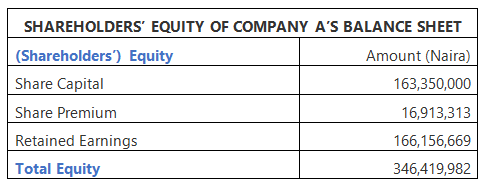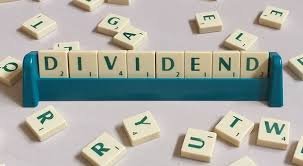In week 3, we were introduced to the asset items, and in week 6, we learnt about the liabilities. One more item remains in our Balance Sheet, that item is the Shareholders’ equity.
What is Shareholders’ equity? Shareholders’ equity is the money attributable to the owner(s) of a business; Shareholder(s). In our discussion last week, we agreed that the funds for the asset comes from liabilities or Shareholders’ equity.
Obi and Ada, the cousins that started Obi and Ada Enterprises had pulled together their savings to start the company. They also got some support from their parents, aunties and uncles, in the form cash investment into their new business in return for a share in the income of the company. Obi, Ada, their parents, aunties and uncles are all Shareholders in the company.
Read; Investing in the Nigerian Financial Market – A Beginner’s Guide
But is their money the only item on the Shareholders’ equity column of the balance sheet? To address this question, we will use the Shareholders’ equity column below. We have extracted this from the balance sheet of a company listed on the Nigerian Stock Exchange, involved in a similar business as Obi & Ada Enterprises.

Table 1: The Shareholders’ equity column from the balance sheet of a company listed on the Nigerian Stock Exchange, for the period ended 31st Dec. 2019
The share capital is the money invested in the business/company. This money unlike the liabilities, is not repaid to the investors in the normal course of the business.
In the case of Obi & Ada Enterprises, the share capital will be the total amount put into the business by Obi, Ada, their parents, aunties and uncles.
Read; A Viable Alternative to get Capital for your Business – The International Finance Corporation (IFC)
Had Obi & Ada Enterprises been a Public Liability Company, listed on a stock exchange like the Nigerian Stock Exchange, then the definition of the term “Share capital” will vary slightly in words, but technically remain the same.
Were it to be a PLC listed on a stock exchange, the company could embark on an Initial Public Offering of the company shares to raise capital for the business. This is done by issuing/selling shares to investors, who will then become shareholders in the company.
We should be mindful that in practice, this is exactly what Obi & Ada had done when they took money from their relatives in exchange for a share in the income of the company.
Broadly speaking then, we can define share capital as the money a company raises by issuing common or preferred stock/share. The amount of share capital or equity financing a company can change over time with the issuance of additional shares.
Read also; Nigeria’s Business Laws and Tax System: What every Business Owner should Know
Our Shareholders’ equity column above show another item termed “Share premium”. The share premium is the difference between the face value of a company’s share and the total amount a company received for the shares. Let us use the below illustration to explain this.
Obi & Ada Enterprises has embarked on an Initial Public Offering to raise N15,000,000.00 by selling 15,000,000 ordinary/common shares to investors. They have calculated that one share would be issued/offered to investors at N1.00. Due to the public interest in the shares of the company, they ended up selling each share for N1.50.
The total money realized therefore is N22,500,000.00, instead of the N15,000,000.00 they had valued the company. The share capital of Obi & Ada Enterprises will still be the N15,000,000.00 that was calculated to be its total face value.
There is N7,500,000.00 realized from the sell of the company shares that has not been recorded. This N7,500,000.00 will appear on the Shareholders’ equity column of the company’s balance sheet as share premium.
Read more; Building a Business based on Local content-Lessons for a would-be Entrepreneur
The share premium can be used to write off equity-related expenses, such as underwriting costs, and may also be used to issue bonus shares.
Obi & Ada Enterprises are in business to make profit, profit that will be shared amongst the shareholders. However, as most of us know, it is not all profits from a business that is shared by the shareholders of the business, some of the profits is retained. This retained earnings can be seen as the third item on the Shareholders’ equity column.
Retained earnings is the amount of profit left over for the business after it has paid out dividend to its shareholders. When the company generates profits, it will be recorded as a positive retained earning. When the company generates losses, it will be recorded as a negative retained earning (or accumulated loses).
Further read; Commodities Exportation in Nigeria: An Insider Account
We have now looked at all the components of a balance sheet; the assets, the liabilities, and the Shareholders’ equity. When put together, what kind of information can the balance sheet show us?
This is the question we will address next week.
Written by;
Nnamdi M.






















































